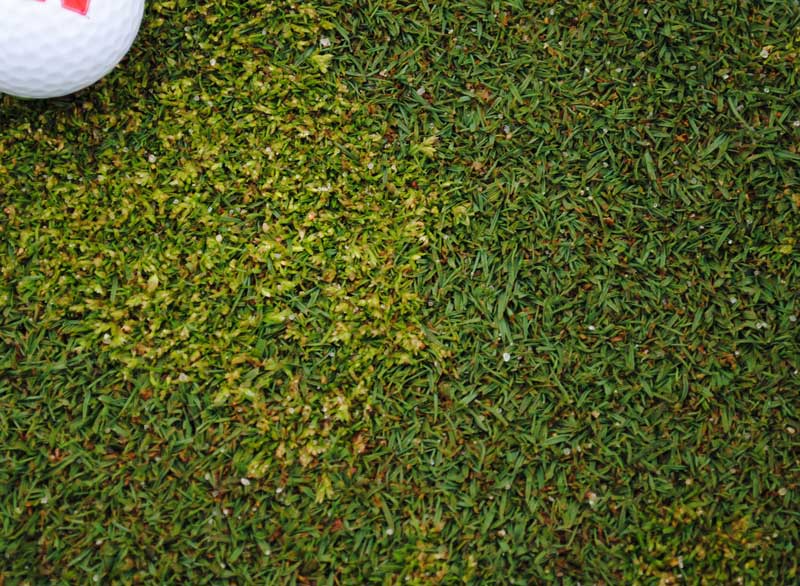Fall Proxy<sup>®</sup> Applications For Improved Seedhead Control Of Annual Bluegrass
Proxy included in the snow mold application or after growth slows in on-snow-mold areas has become a standard to maximize control of annual bluegrass seedheads next spring. Here’s a quick review:
- Specifics for most areas:
- Fall application
- Rate: Proxy 5 oz/1000 sq ft, but do not include PrimoMaxx® in the fall application
- Timing:
- In the final snow mold application in snowy areas
- In areas that don’t go dormant – after the growth slows in late November or December
- Tankmixes:
- Avoid PrimoMaxx® (Syngenta) in the fall application for fear of slight phytotoxicity
- Include a Stressgard-containing product this fall– Adding Signature™ XTRA Stressgard®, Fiata® Stressgard, Interface® Stressgard or Mirage® Stressgard will improve turf quality and expedite spring green-up.
- Proxy reduces spray tank pH, so add it last –The only exception is with Signature XTRA Stressgard, which should be added after Proxy
- Spring application timing
- Better to be early than too late, but the fall application buys a week or two of extra flexibility in the spring
- Growing degree day models are a good estimate for the first application in the spring:
- 200 GDD, base 32F , starting Jan 1
- 50 GDD, base 50F, accumulations starting Feb 1
- The GreenKeeper app is effective for calculating this application
- Boot stage of annual bluegrass seedhead
- Forsythia bloom
- Do not include PrimoMaxx in the first spring application
- 2nd application should be 3-4 weeks after the first or another 200GDD(32) or 50 GDD(50)
- Consider Primo Maxx at 0.125 oz/1000 sq ft in the second and ensuing spring application
- Growing degree day models are a good estimate for the first application in the spring:
- With changing climate, moderate springs, and prolonged seedhead periods, a third and maybe fourth application may be needed on the same interval as the second spring application
- Areas where moderate winter temperatures can result in extended seedhead production – Poa and bentgrass don’t go dormant in coastal areas and parts of the transition zone, so seedheads can be produced throughout much of the winter and spring. Consider:
- Making one fall application after growth slows and then two to four spring applications starting at 200 GDD32 or 50 GDD50, but it’s always better to error on the side of applying earlier in the spring rather than later
- Additional applications? Superintendent experience shows application intervals of 3-4 weeks, 50 GDD50, or 200-400 GDD32 as long as seedheads are occurring
- Rates and application frequency should be based on personal/local experience, as long as state regulations allow applications at rates lower than the label rates and applications do not exceed the maximum (30 oz/1,000 sq. ft./yr west of the Mississippi and 20 oz/1000 sq. ft./yr east of the Mississippi)
- Need more info? Read and follow all label directions. Contact your Envu Area Sales Manager if you need assistance
Fall and spring Proxy recommendations for controlling annual bluegrass seedheads.
| Application | Timings | Product and Use rate per 1,000 sq. ft. |
| Late fall application | With the snow mold fungicide application or after growth slows | Proxy 5.0 oz + Stressgard®-containing fungicide |
| First spring application | Always more effective to be early than late on spring applications. Initial application can be scheduled by:
|
Proxy 5.0 oz + Stressgard®-containing fungicide |
| Second spring application | 3-4 weeks after previous application | Proxy 5.0 oz + PrimoMaxx® 0.125 oz or Stressgard®-containing fungicide |
| Additional applications until seedhead production ceases (if needed) |
2-week intervals 4-week intervals |
Proxy 2.5oz + PrimoMaxx 0.125 oz Proxy 5.0 oz + PrimoMaxx 0.125 oz |

Annual bluegrass seedheads disrupt uniformity and ball roll. (Envu).


